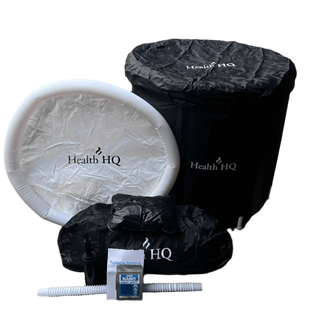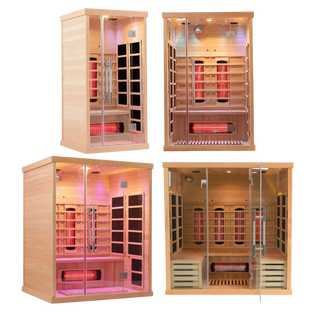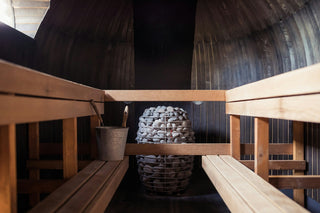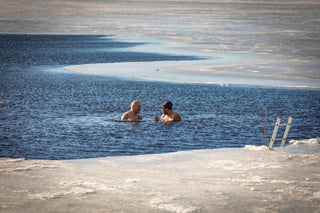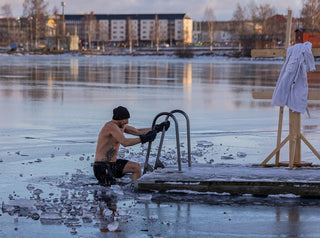How to Choose Between an Electric vs. Wood Stove Traditional Sauna Heater
A traditional sauna heater is the heart of any authentic sauna experience. Whether you opt for the convenience of an electric heater or the rustic charm of a wood-fired stove, each brings its own set of benefits—and trade-offs—in terms of heat-up time, maintenance, cost, and overall ambiance. In this guide, you’ll discover the key differences between electric and wood stove sauna heaters, so you can decide which one best suits your needs and lifestyle.
What Is a Traditional Sauna Heater?
A traditional sauna heater generates and radiates heat to warm the sauna room and its stones, allowing water to be ladled over them to produce steam and boost humidity.
Traditional heaters fall into two main categories:
- Electric heaters, powered by hardwired electrical connections;
- Wood stove heaters, fueled by logs and kindling.
Both deliver the classic dry-heat experience that sauna enthusiasts crave, but differ in installation, operation, and maintenance.
Electric vs. Wood Stove Sauna Heaters: Key Differences
Electric heaters use heating elements encased around sauna stones, controlled via a built-in thermostat or wall-mounted control panel.
Wood stoves burn logs in a firebox beneath or beside the sauna stones, with heat regulated by adjusting airflow and fuel load.
- Control & Convenience
Electric units offer precise temperature control at the flip of a switch; wood stoves require manual tending and airflow adjustment.
- Installation
Electric heaters need a dedicated 240 V circuit and professional wiring; wood stoves demand a chimney or flue installation and a non-combustible hearth.
- Aesthetic & Ambiance
Wood stoves deliver crackling fire sounds, natural wood aromas, and a more authentic feel; electric units are virtually silent and odor-free.
- Ongoing Costs
Electricity costs vary by region; firewood may be cheaper if sourced locally, but requires storage space and splitting.
- Maintenance
Electric heaters need occasional stone replacement and element checks; wood stoves require ash removal, chimney sweeping, and firebox cleaning.
How Fast Do Electric Sauna Heaters Heat Up?
Electric heaters typically reach 160–180 °F (70–82 °C) in 30–45 minutes for a standard 6-8 kW unit in a 6’×6’ sauna.
- Pre-heating (first 10 minutes): Stones begin to warm.
- Steady rise (10–30 minutes): Temperature climbs rapidly to 150 °F.
- Final ramp (30–45 minutes): Hitting optimal range; ready for ladling water.
Tip: Always start heating at least 30 minutes before use for an even, comfortable temperature.
How Fast Do Wood Stove Sauna Heaters Heat Up?
Wood stoves usually take 60–90 minutes to hit 160–180 °F (70–82 °C), depending on:
- Wood quality (dry hardwood vs. softwood)
- Fire size (small vs. roaring blaze)
- Chimney draft (good draft speeds heating)
Staged process:
- Kindling & small logs (first 20 minutes)
- Building the fire (next 20–30 minutes)
- Full blaze (final 20–40 minutes)
Pro Tip: Use well-seasoned hardwood (oak, maple) for faster, hotter fires with less smoke.
Advantages & Disadvantages of Each Type
|
Feature |
Electric Heater |
Wood Stove Heater |
|
Heat-Up Time |
30–45 min |
60–90 min |
|
Temperature Control |
Precise digital or knob control |
Manual via damper and wood load |
|
Installation |
Requires 240 V circuit, less space |
Requires chimney, hearth, more clearance |
|
Atmosphere |
Quiet, odorless |
Rustic fire crackle, wood aroma |
|
Operating Cost |
Dependent on electricity rates |
Firewood cost and labor |
|
Maintenance |
Stone and element checks |
Ash removal, chimney sweeping |
Which Heater Is Best for Your Sauna?
- Choose electric if you value ease, speed, and precise control—ideal for urban homes or rental saunas.
- Choose wood if you crave authenticity, natural ambiance, and don’t mind extra effort—perfect for remote cabins or traditional Finnish-style saunas.
Consider your budget, installation constraints, and how much “hands-on” experience you want. Both deliver the signature dry-heat sauna environment—ultimately, it’s about what experience you prefer.
Choosing between an electric and wood stove sauna heater comes down to your lifestyle, budget, and desired ambiance. Remember to factor in installation requirements, heat-up time, and maintenance when making your decision. Ready to shop? Browse our curated selection of premium sauna heaters and start enjoying your perfect sauna ritual today!


